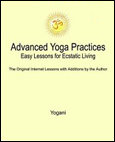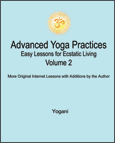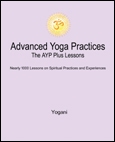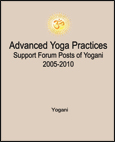|
Public Home | Plus Home | Main Lessons | Tantra Lessons | Public Forum | Plus Forum | Downloads | Books Topic Paths | Search | Training-Retreats | Testimonials | Survey | Interviews | MultiMedia | Contact | Donate |
|
Advanced Yoga Practices Note: For the Original Internet Lessons with additions, see the AYP Easy Lessons Books. For the Expanded and Interactive Internet Lessons, AYP Online Books, Audiobooks and more, see AYP Plus. Lesson 156 - Muladhara/Root and Integration of Practices (Audio)
From: Yogani New Visitors: It is recommended you read from the beginning of the archive, as previous lessons are prerequisite to this one. The first lesson is, "Why This Discussion?"
A: Stimulating the muladhara/root at the perineum is important, but not to the exclusion of everything else. The objective is to activate the root while tying it in with the spiritual awakening of the entire nervous system. In the lessons we use two primary physical methods for physical stimulation of the root - mulabandha/asvini (compression of the anal sphincter) and siddhasana (sitting on the heel). But there is much more to stimulating the root than physical action. A very important method is the one that ties the muladhara up into the entire nervous system energetically -- spinal breathing, which involves breath with attention cycling between the third eye and root. Deep meditation also does this integration of everything "globally" in the nervous system by bringing the mind and body to divine stillness. With samyama, there can be some bouncing also while using the "lightness" technique. It comes from inside, a mental technique only, and the root gets bumped during spontaneous hopping. But focus on muladhara is the last thing in mind while this is happening, because the whole body is filling with light and wanting to lift up. It can be a distraction putting too much attention on the muladhara. It is part of a much greater whole, and we should not become too fixated on it. I suggest you let the muladhara fit in naturally as part of the whole of practices. Allow yourself to go beyond muladhara, higher, through the methods of body, mind and breath. Some letting go in the lower center(s) will not hurt. Then you will be free to do more work higher up in the body. For example, have you tried the "chin pump?" It is a physical method that is very profound, and is covered here in the lessons. It is done high in the body, and ties the muladhara/root in with the illumination of the heart, throat, and head. Let me add that it is possible to address just about everything physically necessary in the muladhara by sitting in siddhasana during practices while the attention goes to all the other methods higher up. In this sense, using siddhasana to stimulate muladhara is a "no-brainer." Once siddhasana is mastered, then everything (spinal breathing, meditation, mulabandha, sambhavi, kechari, nauli, chin pump, kumbhaka, samyama, etc.) can be done without attention being distracted. "Mastered" means able to stay in siddhasana with constant stimulation with attention not stuck on muladhara, and free to do all the other practices. It is not difficult to develop the habit, because siddhasana requires no effort to stay in once established. That is the best situation - stimulation at the muladhara with attention completely free to do all the other practices that open the entire nervous system. Muladhara is the essential beginning of kundalini awakening, but it is not the end. Just as the basement is the essential beginning of a tall building, but the best views are definitely higher up. It is common sense, yes? It is in the integration of a range of practices covering the whole nervous system where huge power is found in yoga. Patanjali's eight limbs of yoga support this view. Any one or two practices done to the exclusion of the others is not the most effective yoga. I suggest you avoid the trap of being stuck on one or two aspects of your nervous system. It takes integrated practices to coax the nervous system to purify and open fully. If this were not so, we would be seeing many more enlightened people in the world today. It is time for a change to more integrated systems of practice, which means balanced consideration of our nervous system and the methods for stimulating it to purify and open. The guru is in you. Discuss this Lesson in the AYP Plus Support Forum Note: For detailed instructions on building a balanced practice routine, see the AYP Eight Limbs of Yoga book, and AYP Plus.
|
|
|

























